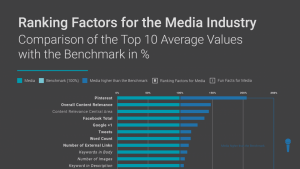Known for its Ranking Factors Study, enterprise SEO and content marketing platform, Searchmetrics recently released the Media Ranking Factors 2017. The report talks about the role of AMP in online media and how media sites should structure their content to perform well in organic search. We spoke to Daniela Neumann, VP Product Management, Searchmetrics, to learn how these factors affect content creation and management.
Html code here! Replace this with any non empty text and that's it.
Tell us about your role at Searchmetrics and the team you handle?
At Searchmetrics our mission is to enable increasing transparency for the modern marketer. And our award-winning search and content optimization platforms provide the foundation for delivering on this. They’re designed to breathe life into an enormous amount of data, turning it into smart, usable insights our customers can use to drive their marketing forward.
But the internet never stands still. Which means we’re constantly innovating to ensure our products keep evolving.
My role is to execute on this, working closely with some of the smartest and most passionate product managers, product marketers, developers and data scientists in the industry. The aim is to make sure our customers are always able to navigate the complexities of the web – and to continually seek out new ways to help them to do it easier, faster and more effectively.
How do the Media Ranking Factors differ from Universal Ranking Factors?
At Searchmetrics, we love ranking factors studies – which we’ve been producing for many years. By analyzing the patterns and correlations in the top search results, these studies have pinpointed the factors that well-performing web pages that rank higher on Google and other important search engines have in common. They provide marketers with essential insights about how to optimize their search and content marketing activities.
But recently we’ve noticed certain changes; simply following the generalized rules and guidelines provided by broad universal ranking factors studies is no longer enough to help you perform well in search. This is because Google’s getting smarter; it now better understands the search intent behind individual queries and knows which elements best satisfy them. This includes knowing what’s required to satisfy search queries within individual vertical sectors.
And, that’s why we’ve developed a series of industry-specific ranking factors studies covering retail, finance, media and other verticals. Our media ranking factors study, for example, has been in great demand among online media and publishers looking for ways to maximize their search performance.

Using our “relevance score” for content within search results, the study reveals for example that content published on media landing pages has to be significantly more relevant to the search topic than content found on high ranking pages in general. And, at the same time, the keyword density for high-ranking URLs in the media industry is far lower than average.
Another insight is that long-form content tends to work better on media sites.
Pages that rank in the top ten results on Google for media related queries have on average 16% more text (around 260 additional words) than URLs that rank on the first page generally.
High-quality images are also more important. Media URLs in the top 10 search results use more images of 200 x 200 pixels than other sites on average. And news and information publishers who’ve enabled fast-loading Accelerated Mobile Pages (AMP) now overwhelmingly top mobile search results. In fact, when we analyzed Google’s mobile results for news related keywords, we saw that 78% of those on page one were AMP-enabled.
To sum up, media websites that perform well in search have longer text than the average with a higher content relevance. This indicates that useful, holistic text content – supported by the use of suitable images – is even more important for media domains than for websites in general.
How should content marketing strategies for mobile-first campaigns, evolve to better the customer experience and increase engagement?
To optimize any customer experience on any device you have to start by understanding who the consumer is and what their specific needs and expectations are. For instance, how does the search intent differ between users on mobile versus desktop devices?
A user searching on a mobile device requires fast answers; ‘take me there quickly and (preferably) replace long lists of search results that I have to spend time scrolling through, with relevant suggestions’. Mobile-oriented content should be crisp, fast, provide suggestions and offer answers to W-type (What, Where, When, Why) questions. An e-commerce platform, for instance, should not create mobile content and functionalities that just mimic its desktop website. While a website can provide a good navigational experience with detailed sections showing categories and product pages, the mobile shop should focus on perfecting product suggestions based on user data – with quick, powerful filters and localization.
Finding what I am looking for, fitted to the device I am using and feeling loved (user-tailored suggestions) creates personalization and positive emotions that lead to lasting engagement.
What is the foundational tenet of the Searchmetrics Visibility Guard? How does this impact SEO performance and reduce risk?
On March 2013, Apple had a 20% drop in organic search visibility, supposedly because parts of the website were unintentionally taken out of the Google search index by Apple employees themselves. It happens to large companies all the time. When many people are working on projects, it is very difficult to keep track of changes and monitor everything. An accidental no-index mistake by a front-end developer might go unnoticed by humans, yet Google’s bots are well trained and prompt. A mistake like this can have a major business impact – in some cases, the cost can be in the range of millions of dollars.
Visibility Guard is an error detection and risk prevention solution that helps avoid this kind of mistake. It triggers automatic alerts, indicating the type of error that’s happened, allowing the business to correct the hiccup before the Google agents notice. You can avoid the immediate loss of search visibility that can threaten the whole business.
The recovery from such a loss, if it were to happen, may take months and is definitely expensive. Visibility Guard is an innovative way of safeguarding one of the key metrics in search performance: organic visibility.
How do you see the definitions of site optimization and online visibility evolving in the race to deliver flawless customer experience and hyper-personalization?
Flawless content can be great if you know where to find it. The first step in ensuring you are listed prominently in search results is to consider the technical performance of your online presence. A good sitemap, consistent internal link building, a proper URL structure, optimized images, fast response times and responsive design are some of the basic criteria. Site optimization essentials such as this are a ‘must do’, upon which great content can be published to ensure a great overall experience.
Great content alone is not enough if no one’s able to find it. And vice versa, highly optimized SEO pages without useful information may appeal to Google’s bots but will suffer from high bounce rates and little user attention, eventually leading to declining rankings.
How does Searchmetrics use AI/ML and other machine-level automation to improve content discovery, engagement, and ROI?
Maybe we can start from the perspective of what may be the most expensive piece of information all content marketers would love to get their hands on? High on the list would be wanting to figure out the intricacies of consumer search behavior: searchers’ preferences, predispositions, their points of saturation, their points of excitement, the length of engagement etc.
We also wanted to know these answers. That’s why Searchmetrics has been developing smart algorithms that for example:
1. Predict the user search behavior in a specific geographical context and time (seasonality)
2. Focus on extracting the user buying intention and cluster that according to stages of engagement in relation to a product or service.
3. Focus on understanding the psychology behind search intent. Does someone searching for “apple” want to buy an Apple product, expect a list of organic grocery stores, want to start a green business’ or are they thinking of visiting New York?
With the Searchmetrics Topic Explorer – another powerful tool for research and content refinement – we help millions of users define their content strategy by deciding what topics are relevant depending on the type of search behavior, the geographical context and intention of search.
Thank you for chatting with us, Daniela.
Stay tuned for more insights on marketing technologies. To participate in our Tech Bytes program, email us at news@martechseries-67ee47.ingress-bonde.easywp.com











